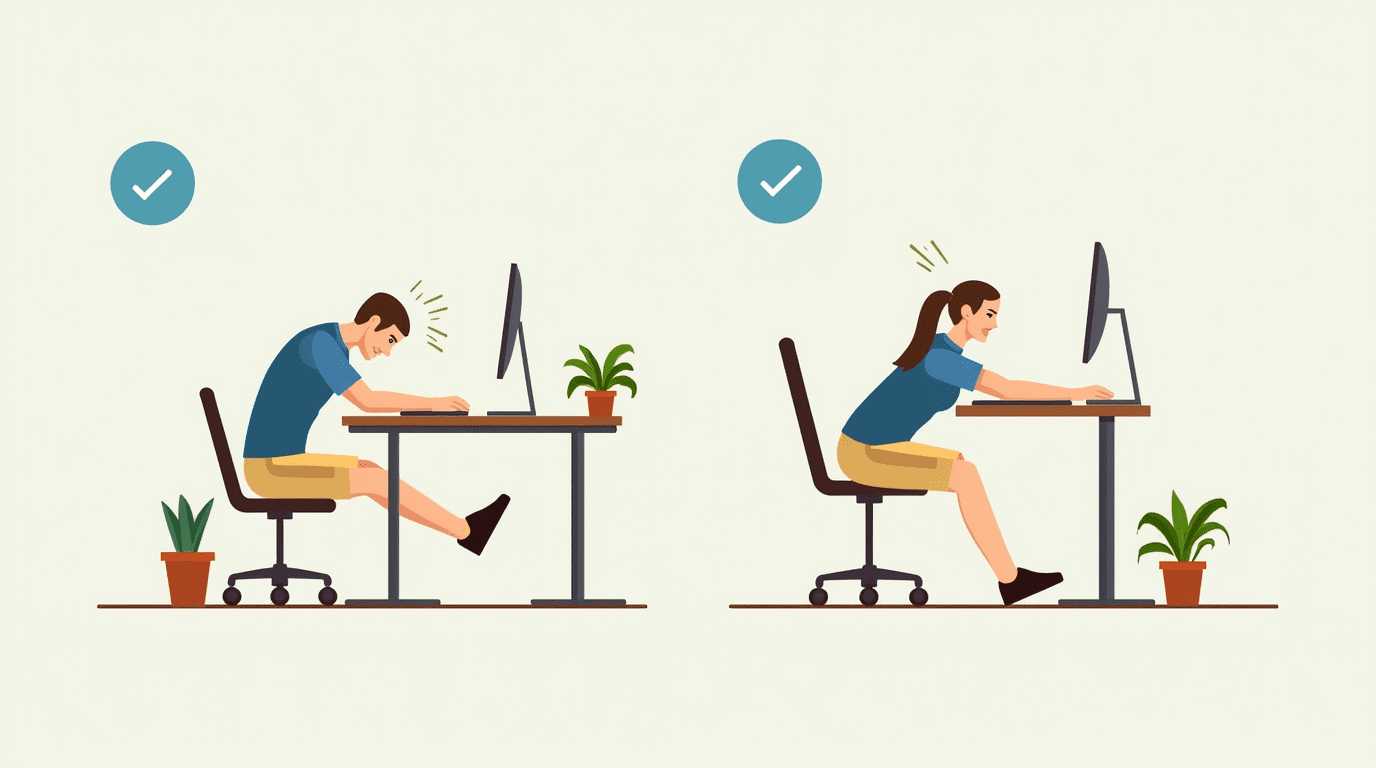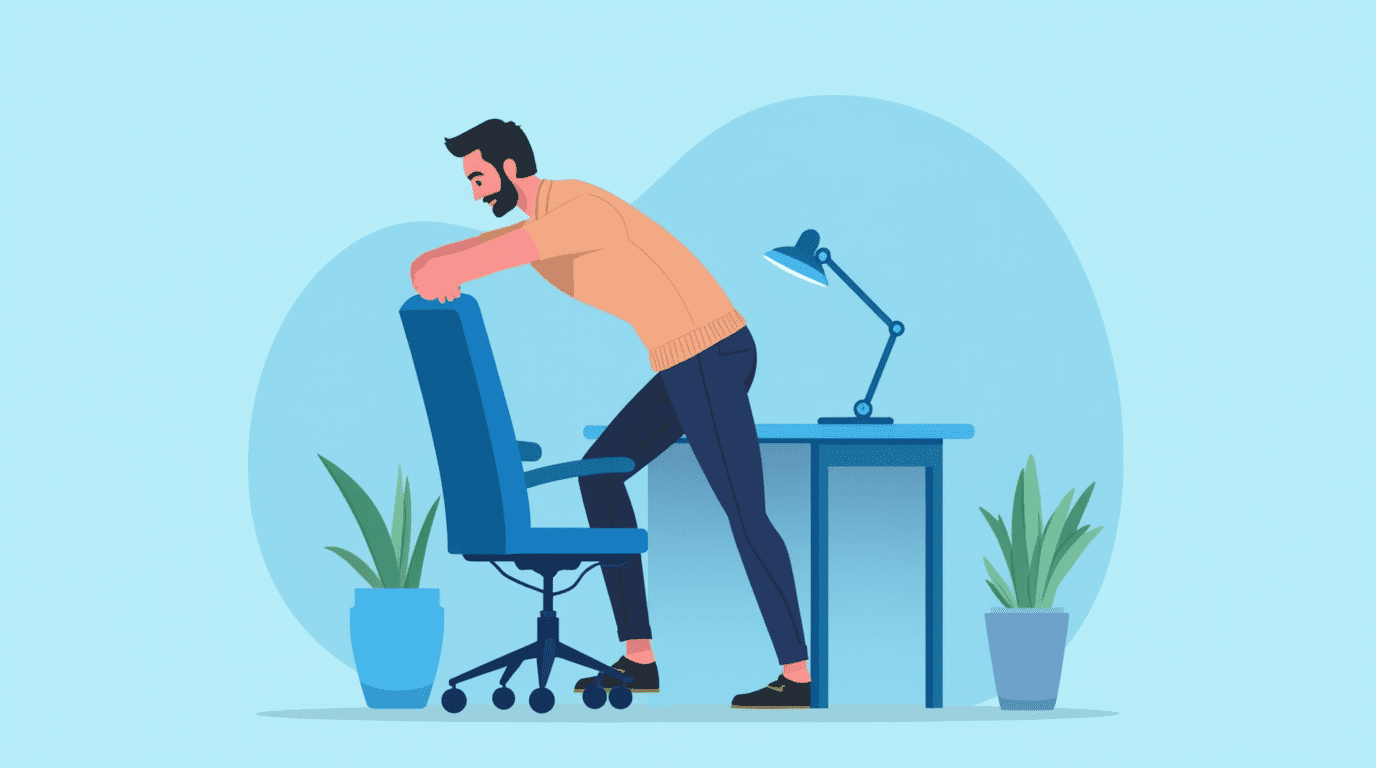Importance of Desk Stretches
Relieving Long Hours Pain
Performing simple [seated desk stretches] regularly can alleviate the discomfort associated with prolonged sitting. Sitting for long hours can lead to stiffness and pain in various parts of the body, particularly the neck, back, and shoulders. By incorporating stretches into your routine, you can target these areas, offering relief from pain and minimizing long-term damage.
Moreover, daily stretching can enhance blood circulation to the muscles, which helps in reducing muscle fatigue and soreness. Improved blood flow not only prepares your muscles for activity but also aids in quicker recovery. This is particularly beneficial for desk workers who may not get enough physical activity during the day (MPOWERMD).
Reversing Harmful Effects
The sedentary nature of desk jobs can have several adverse effects on health. An analysis of job industry trends over the past 50 years has shown that at least 8 in 10 American workers are predominantly sedentary, which can contribute to a host of health issues (Healthline). Regular stretching and movement can counteract some of these harmful effects, significantly improving physical well-being and productivity.
Proper posture plays a critical role in mitigating the negative impacts of prolonged sitting. One of the golden rules is to sit on your sitting bones and not your tailbone. Maintaining an open chest and ensuring that the ‘pointy bony bit on the top of your shoulder’ is pointing straight upwards can greatly enhance your sitting posture (300Hours).
Additionally, regular movement encourages the expansion of the range of motion, which is essential for maintaining flexibility and reducing the risk of injury. Consider incorporating some quick desk stretches or easy desk stretches into your routine to enhance your overall well-being.
By taking a few minutes throughout the day to perform these stretches, desk workers can reverse some of the detrimental effects of prolonged sitting and improve their overall health. For more specific stretches targeting areas of concern, such as the lower back or neck and shoulders, visit our articles on desk stretches for lower back and desk stretches for neck and shoulders.
Specific Seated Stretches

Incorporating specific seated desk stretches into your daily routine can help desk workers relieve pain and reverse the harmful effects of prolonged sitting. Here are some effective stretches:
Side Neck Stretch
The Side Neck Stretch is a simple yet effective way to relieve neck tension caused by long hours of sitting.
- Instructions: Sit up straight, and slowly tilt your head towards one shoulder. Hold for 15-30 seconds, then switch sides. Repeat 2-3 times.
This stretch helps alleviate stiffness and improves flexibility in the neck. For more neck and shoulder stretches, check out our desk stretches for neck and shoulders.
Turtle Stretch
The Turtle Stretch eases tension in the upper back and shoulders.
- Instructions: Sit tall, tuck your chin towards your chest, and extend your arms forward. Hold for 20-30 seconds.
By performing this stretch, desk workers can effectively reduce shoulder strain and enhance posture. For additional quick stretches, see our quick desk stretches.
Hip Opener Stretch
The Hip Opener Stretch targets the hips and lower back, areas often affected by prolonged sitting.
- Instructions: Sit with your feet flat on the floor. Place one ankle on the opposite knee. Lean forward gently. Hold for 15-30 seconds, then switch legs.
This stretch helps increase flexibility and reduce tension in the hip area. Discover more lower back stretches at desk stretches for lower back.
Forward Bend Stretch
The Forward Bend Stretch is effective for stretching the entire back and relieving stress.
- Instructions: Sit at the edge of your chair, extend your legs, and reach your hands towards your feet. Hold for 20-30 seconds.
This stretch promotes better circulation and helps to release tension in the back. More easy stretches can be found at easy desk stretches.
Simple Twist Stretch
The Simple Twist Stretch aids in improving spinal mobility and easing lower back pain.
- Instructions: Sit up straight, place your right hand on the back of the chair and your left hand on your right thigh. Twist your torso gently to the right. Hold for 15-30 seconds, then switch sides.
Performing this stretch regularly can enhance flexibility and help relieve lower back discomfort.
Incorporating these specific seated stretches can promote healthier sitting habits and mitigate discomfort. Always remember to move intermittently throughout your day to maintain optimum health and productivity meQuilibrium.
Health Benefits of Stretching

Regular stretching brings numerous benefits, especially for desk workers who spend long hours sitting. Here, we outline the key health benefits of incorporating seated desk stretches into your daily routine.
Increasing Blood Flow
Stretching daily increases blood flow to your muscles, enhancing circulation and oxygen delivery. This helps keep your muscles nourished and reduces the risk of stiffness and soreness. Regular movement can significantly improve your physical well-being and productivity, especially in sedentary environments.
| Benefit | Description |
|---|---|
| Increased Oxygen Delivery | Enhanced blood flow brings more oxygen to muscle tissues. |
| Reduced Stiffness | Keeps muscles flexible and reduces soreness. |
| Enhanced Productivity | Better physical well-being correlates with increased work output. |
Improving Posture
Proper posture is crucial for maintaining good health, especially if you’re seated for extended periods. Stretching exercises, such as the Trunk Rotation Stretch, help in strengthening muscles and aligning the spine. This improves your posture and reduces the strain on your back and neck.
Incorporating stretches can prevent musculoskeletal issues, making your seated time more comfortable and beneficial.
| Benefit | Description |
|---|---|
| Spinal Alignment | Helps in maintaining natural spine curvature. |
| Muscle Strengthening | Focuses on muscles that support good posture. |
| Reduced Strain | Lessens pressure on back and neck muscles. |
Relieving Back Pain
Stretching specific muscles can work wonders in relieving back pain, a common issue among desk workers. Regular stretches increase flexibility and prepare your muscles for sitting for long periods. For effective relief, consider desk stretches for the lower back and desk stretches for neck and shoulders.
| Benefit | Description |
|---|---|
| Increased Flexibility | Makes muscles more flexible, reducing pain. |
| Back Muscle Preparation | Prepares muscles for prolonged sitting. |
| Pain Reduction | Directly alleviates tension in the back. |
Incorporating stretching into your daily work routine not only brings immediate relief but also contributes to long-term wellness. For ideas on incorporating stretching into your day, check out our guide on quick desk stretches.
Impact of Prolonged Sitting
The modern desk job demands long hours of sitting, which can have significant impacts on health. Understanding these risks and the importance of integrating intermittent movement is crucial for desk workers.
Risks for Various Health Conditions
Prolonged sitting can elevate the risk for multiple health conditions. Harvard Health indicates that habitual inactivity raises the likelihood of obesity, diabetes, cardiovascular disease, deep-vein thrombosis, and metabolic syndrome. Remaining stationary for long durations, coupled with poor posture and repetitive motions, can lead to or exacerbate musculoskeletal disorders (Healthline).
A table summarizing the risks associated with prolonged sitting:
| Health Condition | Risk Increase |
|---|---|
| Obesity | High |
| Diabetes | High |
| Cardiovascular Disease | High |
| Deep-Vein Thrombosis | Moderate |
| Metabolic Syndrome | High |
| Musculoskeletal Disorders | High |
An analysis of job industry trends over the past fifty years shows that at least 8 in 10 American workers have sedentary jobs, leading to discomfort and various health issues related to desk work.
Importance of Intermittent Movement
Introducing intermittent movement throughout the workday is crucial in mitigating the adverse effects of prolonged sitting. Simple seated desk stretches can alleviate pain and gradually reverse some of the harmful impacts. Intermittent movement, like short walks or simple stretches, can help maintain a healthy neck and back (meQuilibrium).
Regular movement has been shown to improve both physical well-being and productivity in a sedentary environment. By incorporating quick desk stretches and taking regular breaks, desk workers can significantly reduce the risk of health complications and enhance overall workplace comfort. For more specific stretches targeting areas of concern, explore our articles on desk stretches for lower back and desk stretches for neck and shoulders.
Workplace Stretching Programs
Implementing workplace stretching programs has been found to offer several benefits, especially for desk workers who spend long hours sitting. These programs can significantly improve range of motion, enhance posture, and provide stress relief.
Range of Motion Improvement
One of the primary advantages of incorporating stretching routines at the workplace is the improvement in range of motion. Regular stretching helps maintain joint flexibility and muscle elasticity, which are crucial for performing daily tasks and preventing injuries. Research suggests that periodic workplace stretching may reduce pain by up to 72 percent (Healthline). Consider incorporating seated desk stretches like the Trunk Rotation Stretch and Hamstring Stretch to enhance mobility.
| Stretch Type | Range of Motion Improvement (%) |
|---|---|
| Trunk Rotation Stretch | 50% |
| Hamstring Stretch | 60% |
Posture Enhancement
Posture problems are common among desk workers due to prolonged sitting. Implementing stretching programs can help in alleviating these issues by strengthening the muscles that support the spine. Stretching routines like the Chest Opener Stretch and Upper Body Stretch can provide relief and enhance posture by correcting musculoskeletal imbalances and reducing slouching tendencies.
Effective stretches for posture:
- Chest Opener Stretch
- Upper Body Stretch
Stress Relief Benefits
Stretching at the workplace not only helps in physical well-being but also provides significant mental health benefits. Some studies indicate that even a bit of exercise during the workday can relieve both physical and mental stress, enhancing overall employee well-being (MPOWER Physical Therapy). Paralleling these findings, integrating simple stretches like the Neck Stretch and the Hip Opener Stretch can foster a stress-free work environment.
| Stretch Type | Stress Relief Rating |
|---|---|
| Neck Stretch | High |
| Hip Opener Stretch | Moderate |
By incorporating these stretching exercises, desk workers can benefit from improved flexibility, better posture, and reduced stress levels. For more effective desk stretches, check our guides on quick desk stretches and easy desk stretches.
Effective Desk Stretches
Seated desk stretches can be extremely beneficial for desk workers who spend long hours sitting. Here are some effective stretches you can do right at your desk to alleviate tension and improve your overall well-being.
Trunk Rotation Stretch
The Trunk Rotation Stretch is excellent for reducing tension in your upper body.
- Sit upright with your feet flat on the ground.
- Place your right hand on the back of the chair.
- Twist your torso to the right and hold for 15-20 seconds.
- Repeat on the other side.
This stretch helps in improving posture and increasing spinal mobility.
Chest Opener Stretch
The Chest Opener Stretch targets the chest and shoulders, which can become tight from prolonged sitting.
- Sit on the edge of your chair with your feet firmly planted on the floor.
- Clasp your hands behind your back and push your chest forward.
- Hold the stretch for 15-20 seconds.
Incorporate this into your routine for better chest and shoulder flexibility.
Upper Body Stretch
The Upper Body Stretch is ideal for stretching your arms, shoulders, and upper back.
- Extend your arms straight in front of you.
- Interlace your fingers and push your hands away from your body.
- Hold this stretch for 15-20 seconds.
Adding this stretch can relieve upper body tension effectively.
Hamstring Stretch
The Hamstring Stretch can be performed seated and is great for easing lower body stiffness.
- Sit on the edge of your chair with one leg extended straight out.
- Reach towards your toes while keeping your back straight.
- Hold this position for 15-20 seconds and repeat on the other leg.
This stretch can significantly help in alleviating lower back pain.
Neck Stretch
Finally, the Neck Stretch is crucial for reducing neck stiffness and pain.
- Sit up straight and slowly tilt your head towards your right shoulder.
- Hold this position for 15-20 seconds.
- Repeat on the other side.
Include this stretch in your routine to tackle neck strain effectively (MPOWERMD).
For more desk stretches and tips on maintaining a healthy posture, check out our articles on easy desk stretches and quick desk stretches.



